Special Report
Countries Spending the Most on War

Published:
Last Updated:

The United States spent $611 billion on its military last year, up slightly from about $596 billion the year prior. American military spending dwarfs that of every other nation in the world.. Second-place China spent barely one-third as much on its armed forces.
While it will not likely be surpassed any time soon, U.S. military spending has declined by about 5% over the past decade. Meanwhile, China, Russia, and other major powers have substantially increased spending — China’s spending is up by 118% over the same period.
[in-text-ad]
Based on annual military spending estimates from the Stockholm International Peace Research Institute (SIPRI), 24/7 Wall St. reviewed the 15 countries with the largest military expenditure in 2016.
Click here to see the countries spending the most on war.
While it is not The United States’ long history of involvement in foreign conflicts helps explain why its military dwarfs that of any other nation. Long considered the world’s policeman, the United States has nearly 800 bases in over 70 countries.
The U.S. spending decline over the past decade has been accompanied with either minimal growth or even decline in spending in a number of Western nations. In the U.K., which at one time was America’s primary ally in the war in Afghanistan, spending fell by 12% over the last 10 years. Several major U.S. allies also spend relatively little compared to the size of their economies. Germany, Japan, and Italy each spent less than 2% of GDP on their military compared to the U.S. expenditure of 3.3% of GDP.
Many of the top military spenders spend disproportional amounts to the size of their economies and populations. The United Arab Emirates, Israel, and Saudi Arabia are each among the top 15 military spenders despite being less populous than most other nations on this list. Neither Saudi Arabia nor the UAE are among the 40 most populous nations, and Israel ranks 92nd overall. Each also spends more than 5% of GDP on defense.
Each of these three nations has relatively high GDP per capita, but these nations spend more proportional even to their wealthier economies. Each spends at least 5% of GDP on the military. Saudi Arabia, which has the world’s fourth largest defense budget, spends 10% of GDP on its armed forces. The three are also all in the Middle East — a relatively unstable region that in recent years has been the site of several major wars, uprisings, and insurgencies. The area’s constant conflicts may also explain the need for high spending on military.
To identify the countries countries spending the most on war, 24/7 Wall St. reviewed 2016 military expenditures estimated by the Stockholm International Peace Research Institute (SIPRI) in its most recent annual “Trends in World Military Expenditure, 2016” report. Spending as a share of GDP, per capita expenditure, and absolute spending figures for 2016 and 2007 also came from SIPRI. Military expenditure data include all current and capital expenditure on:
• The armed forces, including peacekeeping forces
• Defence ministries and other government agencies engaged in defence projects
• Paramilitary forces, when judged to be trained and equipped for military operations
• Military space activities
• Military and civil personnel, including retirement pensions and social services for military personnel
• Operations and maintenance
• Procurement
• Military research and development
• Military aid (in the military expenditure of the donor country)
These are the countries spending the most on the military.
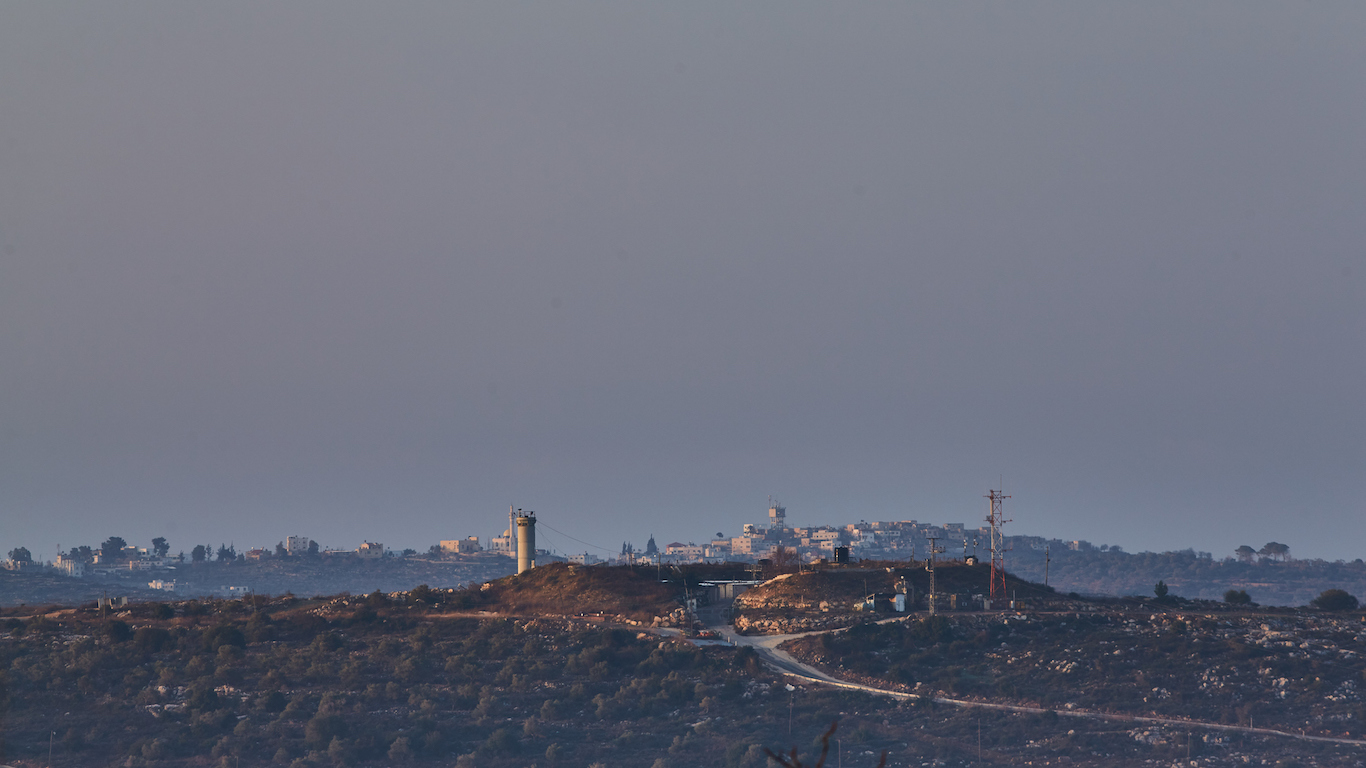
15. Israel
> Military expenditure: $18.0 billion
> Pct. change military expenditure, 2007-2016: 19.0%
> Expenditure as pct. of GDP: 5.8%
> Per capita military expenditure: $2,194
Often embattled in military conflict since becoming a country in 1948, Israel is one of the largest military spenders in the world. Military service is mandatory for all Israeli citizens, with three years of service required for men and two for women. Defense spending amounts to 5.8% of Israel’s GDP, one of the largest shares in the world. With a population of approximately 8.4 million, Israel spends more on defense per citizen than nearly any other country. The Israeli defense budget, at $2,194 per capita, is more than any country other than the UAE.
[in-text-ad]
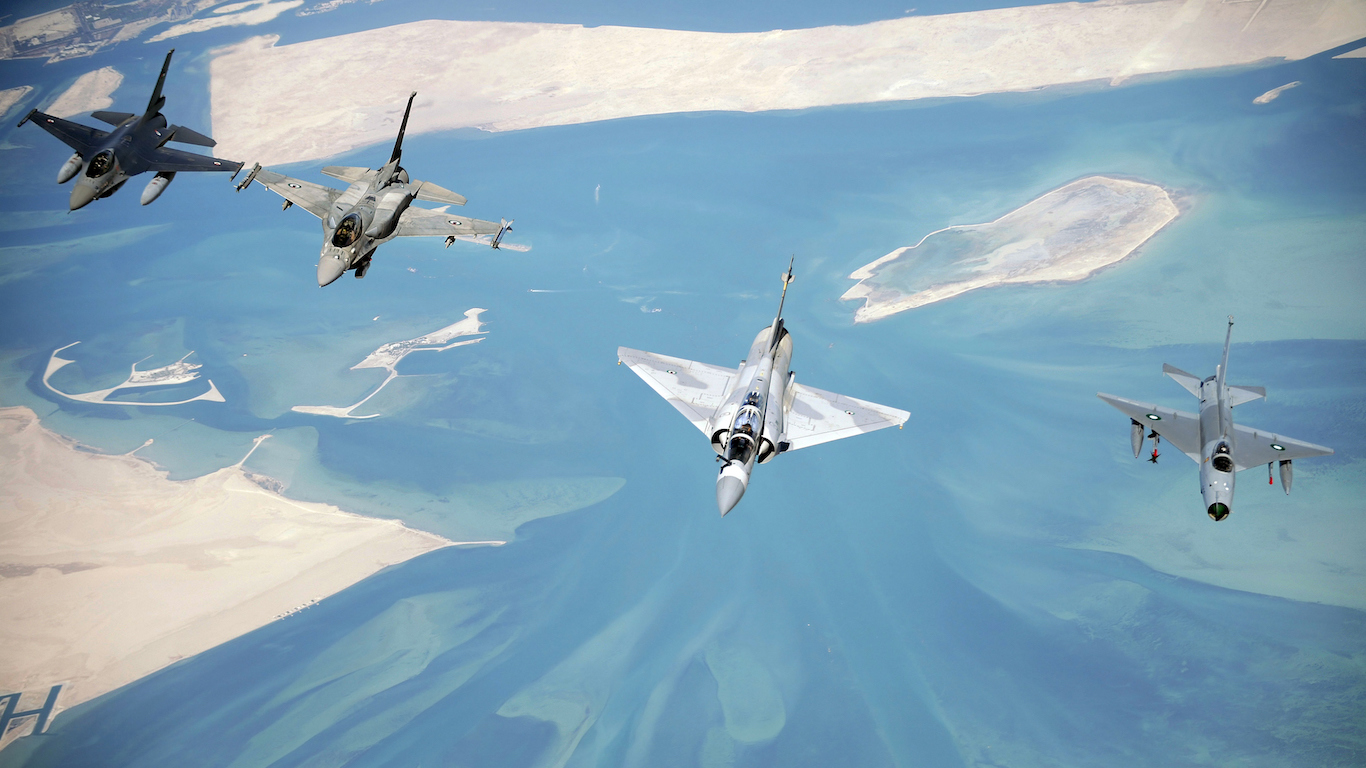
14. UAE
> Military expenditure: $22.8 billion
> Pct. change military expenditure, 2007-2016: 123.0%
> Expenditure as pct. of GDP: 5.7%
> Per capita military expenditure: $2,504
Despite the decline in oil prices, OPEC member the United Arab Emirates military expenditure continues to increase. The country spent $22.8 billion on defense last year, more than most countries. With a population of 9.2 million, the UAE spends more on defense per citizen than any country in the world, at $2,504 per capita. The nation’s military is largely concerned with border control, intelligence gathering, and the protection of its oil and gas infrastructure. The UAE is also a major American ally and hosts U.S. Air Force operations at its Al Dhafra airbase.
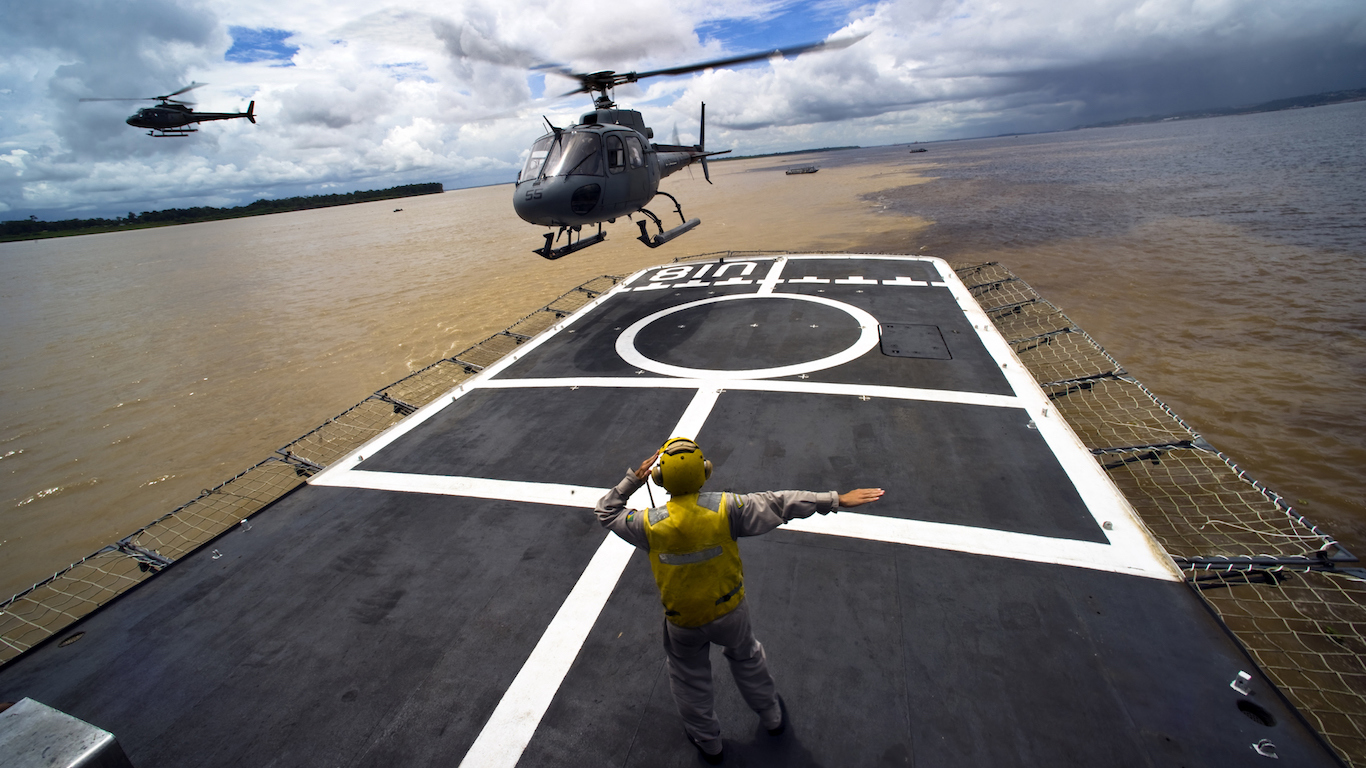
13. Brazil
> Military expenditure: $23.7 billion
> Pct. change military expenditure, 2007-2016: 18.0%
> Expenditure as pct. of GDP: 1.3%
> Per capita military expenditure: $113
While Brazil’s military spending increased by 18% from 2007, more recently spending has declined due to worsening economic recession. The ongoing economic impacts of the decline in oil prices continues to force government in Brazil and other oil-exporting national economies to cut spending.
A nation’s military is typically deployed to wield influence outside a country’s borders. In Brazil, however, a relatively large portion of state power has been used in recent years to regain control of favelas — clusters of very low income neighborhoods — from gangs. Like several other large military powers, military service is mandatory in Brazil.

12. Australia
> Military expenditure: $24.6 billion
> Pct. change military expenditure, 2007-2016: 29.0%
> Expenditure as pct. of GDP: 2.0%
> Per capita military expenditure: $1,013
Australia has steadily increased its military expenditure over the past decade, with spending rising 29% from 2007 to 2016. The country spent $24.6 billion on defense in 2016 and plans to increase spending further over the next 10 years as well. The increase is largely in response to rising military tensions in the area. In a defense white paper outlining the country’s military strategy, Australian leadership highlighted territorial disputes on the South China Sea and terrorist attacks in Western Europe among the reasons for the buildup. Australia’s defense budget currently amounts to 2% of GDP, one of the larger shares worldwide and in accordance with NATO’s recommended military spending levels. Depending on the country’s GDP growth, Australian defense spending may exceed 2% of GDP in the near future.
[in-text-ad-2]
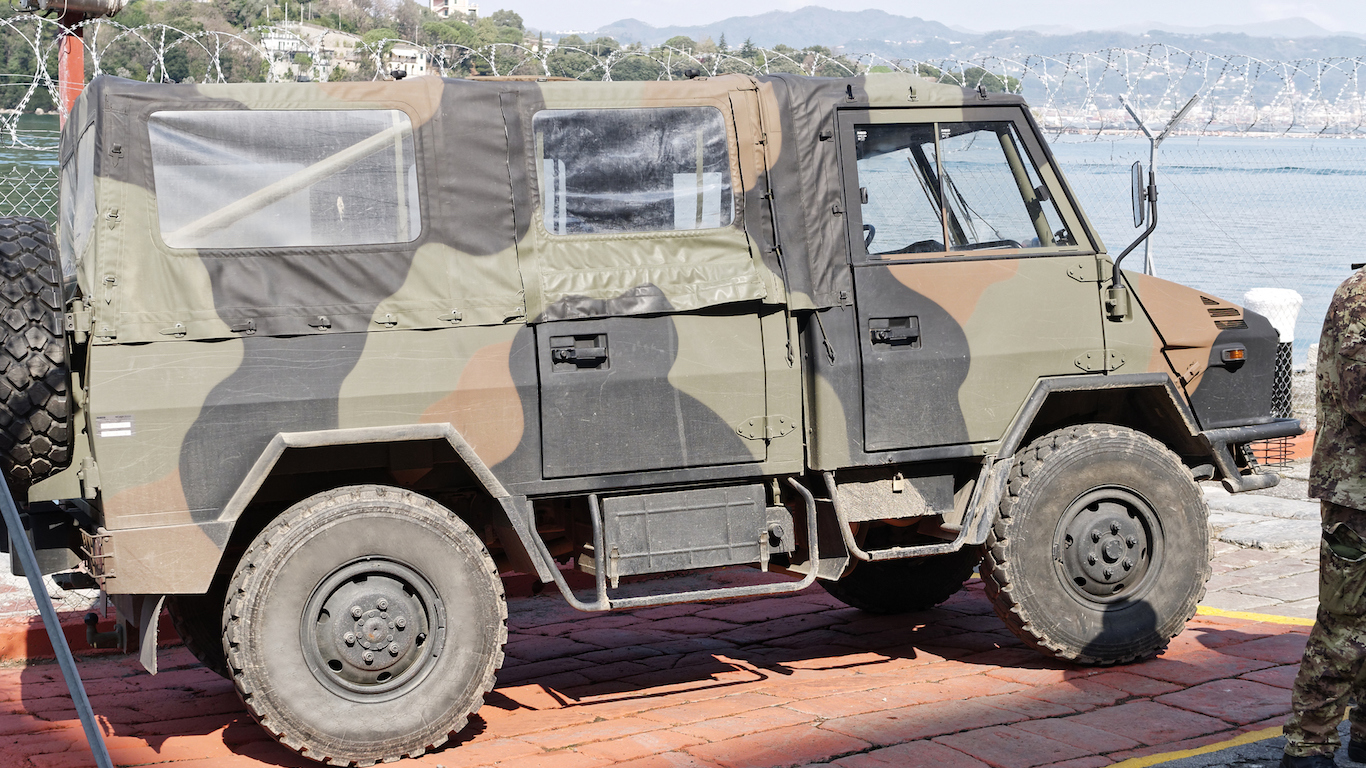
11. Italy
> Military expenditure: $27.9 billion
> Pct. change military expenditure, 2007-2016: -16.0%
> Expenditure as pct. of GDP: 1.5%
> Per capita military expenditure: $467
Despite declining by 16% over the past decade, Italian military spending increased by 11% to $27.9 billion in 2016. According to SIPRI, the increase was partly the result of the government’s support of local arms manufacturers through domestic procurement. Italy’s defense budget peaked in 2004, a year after the country first dispatched troops to Iraq.
Today, the Italian military is heavily involved in international peacekeeping efforts in conjunction with the United Nations. The Italian Armed Forces also has a large domestic presence through the carabinieri, the nation’s military police. The country’s defense budget amounts to 1.5% of its GDP, one of the smaller shares among the world’s largest military spenders.
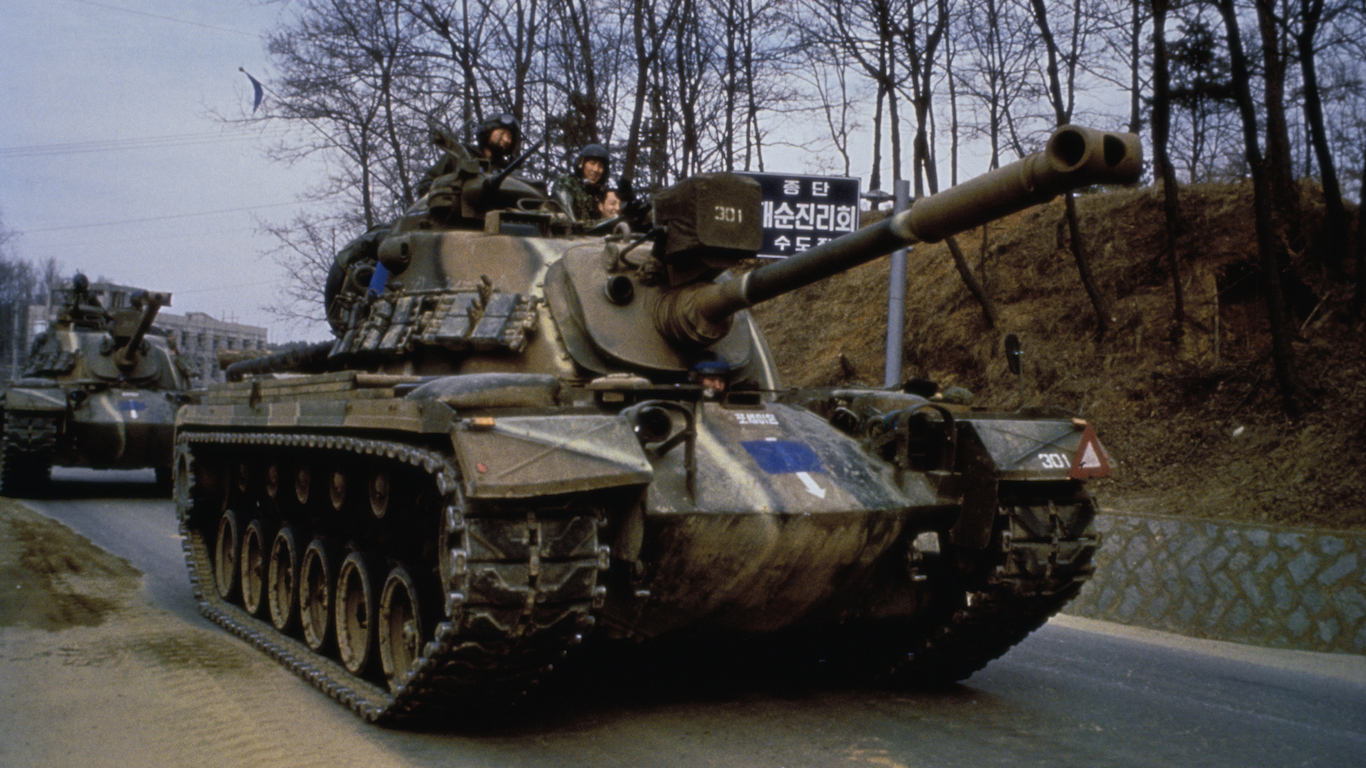
10. South Korea
> Military expenditure: $36.8 billion
> Pct. change military expenditure, 2007-2016: 35.0%
> Expenditure as pct. of GDP: 2.7%
> Per capita military expenditure: $729
South Korea spent an estimated $36.8 billion on defense in 2016, up by 35% from 2007. Military spending has steadily increased over the past decade and will likely continue to rise in the coming years as North Korea exhibits increased military aggression. At the end of last year, South Korea approved for 2017 the largest military budget in its history. South Korea’s northern neighbor conducted 25 ballistic missile and two nuclear tests in 2016, and leader Kim Jong-un has explicitly stated his unwillingness to abandon the country’s military buildup. While South Korea spends approximately 2.7% of its GDP on defense, research from Amnesty International East Asia estimates that North Korea, on the other hand, spends an estimated 22% of GDP on its military. South Korea has announced it will increase its defense budget by $8.0 billion over the next five years.
[in-text-ad]
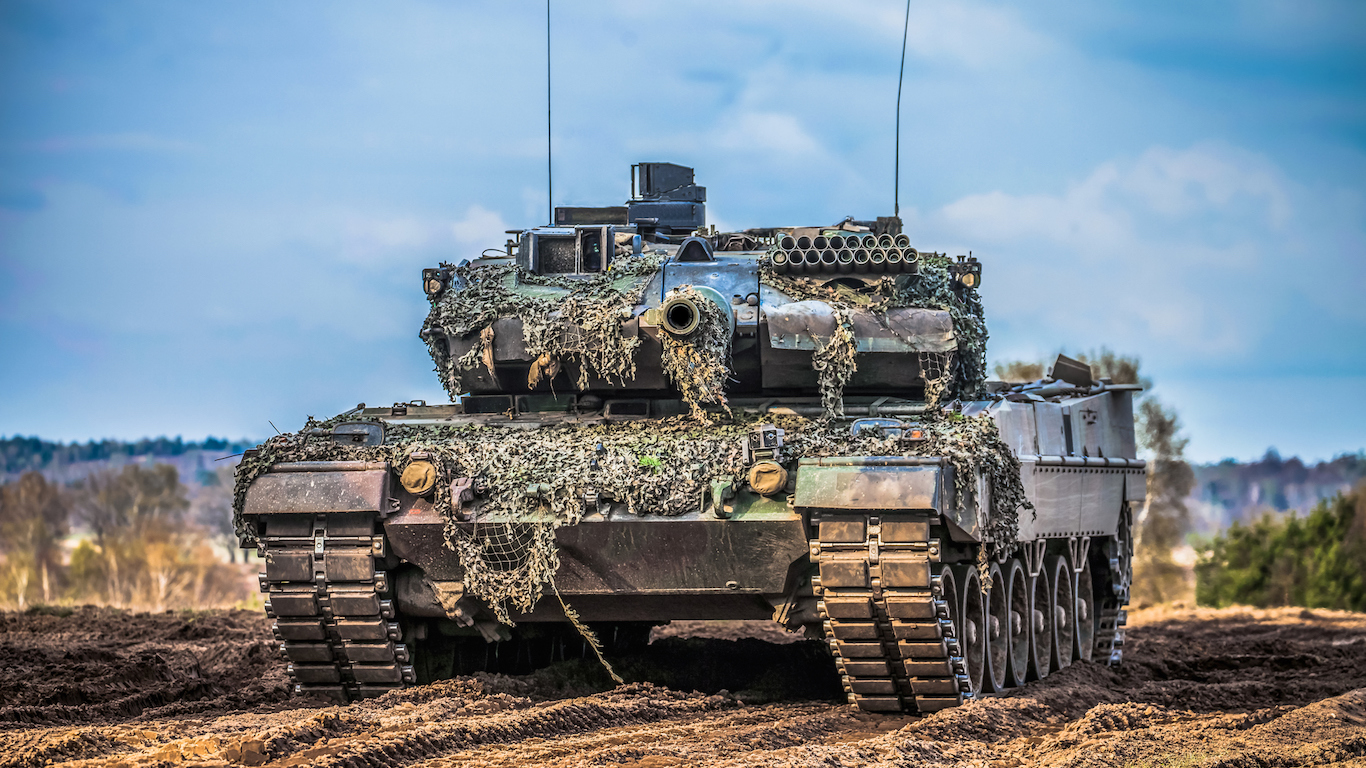
9. Germany
> Military expenditure: $41.1 billion
> Pct. change military expenditure, 2007-2016: 6.8%
> Expenditure as pct. of GDP: 1.2%
> Per capita military expenditure: $509
Germany has by far the largest economy in Europe, yet ranked third on the continent in military spending in 2016, behind France and the U.K. Germany spends just 1.2% of its GDP on defense, while the U.K. spends 1.9% and France spends 2.3% — nearly double Germany’s expenditure. Germany’s total spending has increased more than other major European powers, however, increasing by 6.8% from 2007 through 2016. Meanwhile, France’s spending rose by 2.8%, and U.K. arms expenditure fell by 12%. Payroll increases do not likely account for Germany’s increased military expenditure. The total number of Germans in the military has plummeted over the past two decades from about 365,000 armed forces personnel in 1995 to 177,300 in 2015.

8. Japan
> Military expenditure: $46.1 billion
> Pct. change military expenditure, 2007-2016: 2.5%
> Expenditure as pct. of GDP: 1.0%
> Per capita military expenditure: $365
Japan is one of five countries on this list located in Asia and Oceania. High spending in the region is fueled by escalating tensions. Japan is in the midst of a decades-long dispute with China over an uninhabited island chain in the East China Sea. In recent years, Japan has invested in missile and radar technology to counter similar investments made by the Chinese. Japan’s 2017 military budget includes funding five new patrol ships and 200 new maritime law enforcement staff. Japan’s latest military budget also allocates money to its ballistic missile defense system in response to rising threats from North Korea’s nuclear program.
While Japan spends more on its military than all but seven other countries, as a share of GDP Japan’s military expenditure is relatively small. Japan allocates only 1.0% of its GDP on its military, a smaller share than the majority of countries and well below the 3.3% share the U.S. spends.
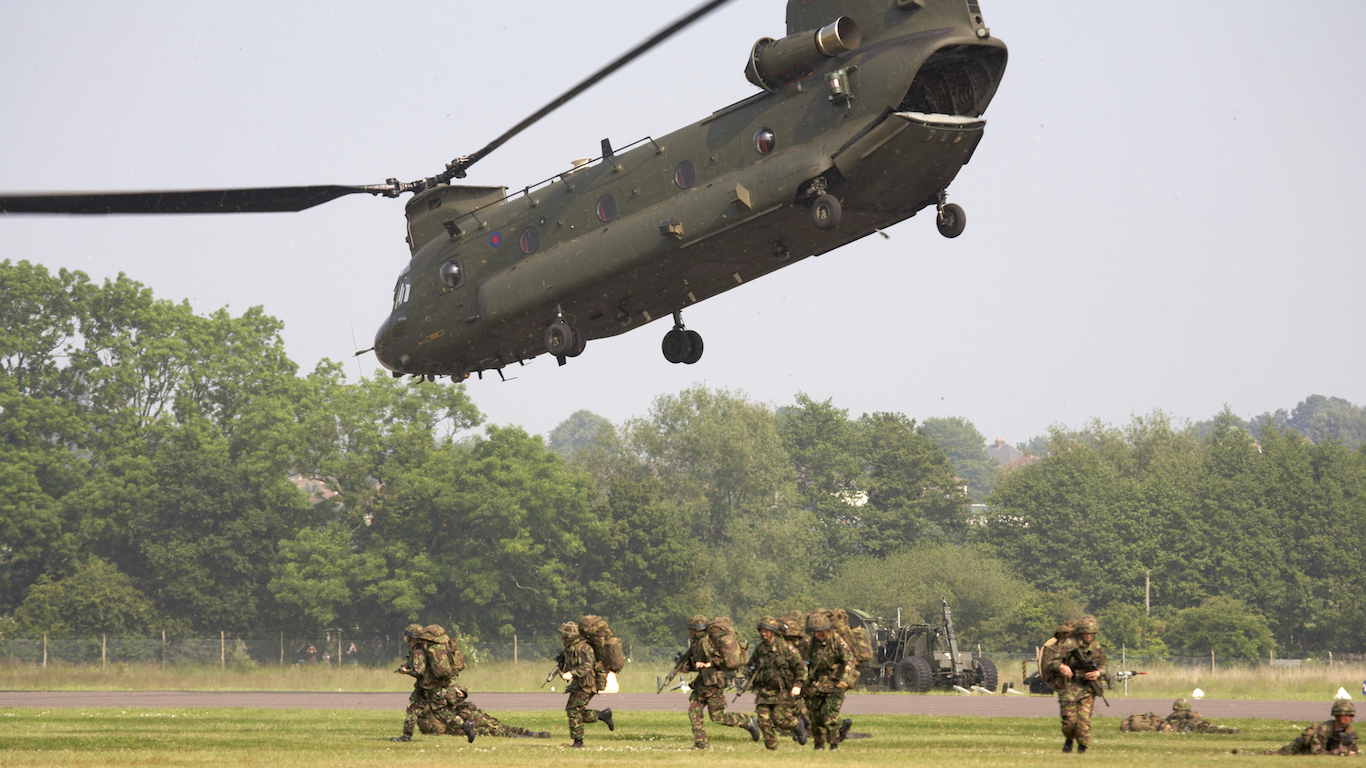
7. United Kingdom
> Military expenditure: $48.3 billion
> Pct. change military expenditure, 2007-2016: -12.0%
> Expenditure as pct. of GDP: 1.9%
> Per capita military expenditure: $741
Like in Italy and the United States, defense spending in the United Kingdom has fallen over the past decade — the only three countries among the top 15 military spenders where this was the case. U.K. military expenditure fell 12% between 2007 and 2016, reaching $48.3 billion last year — the country’s smallest defense budget since 1999. The U.K. spent 1.9% of GDP on military and faced criticism from some NATO countries for failing to meet NATO’s 2% target. In April 2016, however, the country announced it would increase military spending at 0.5% above inflation annually until 2021 in order to meet the NATO target.
[in-text-ad-2]
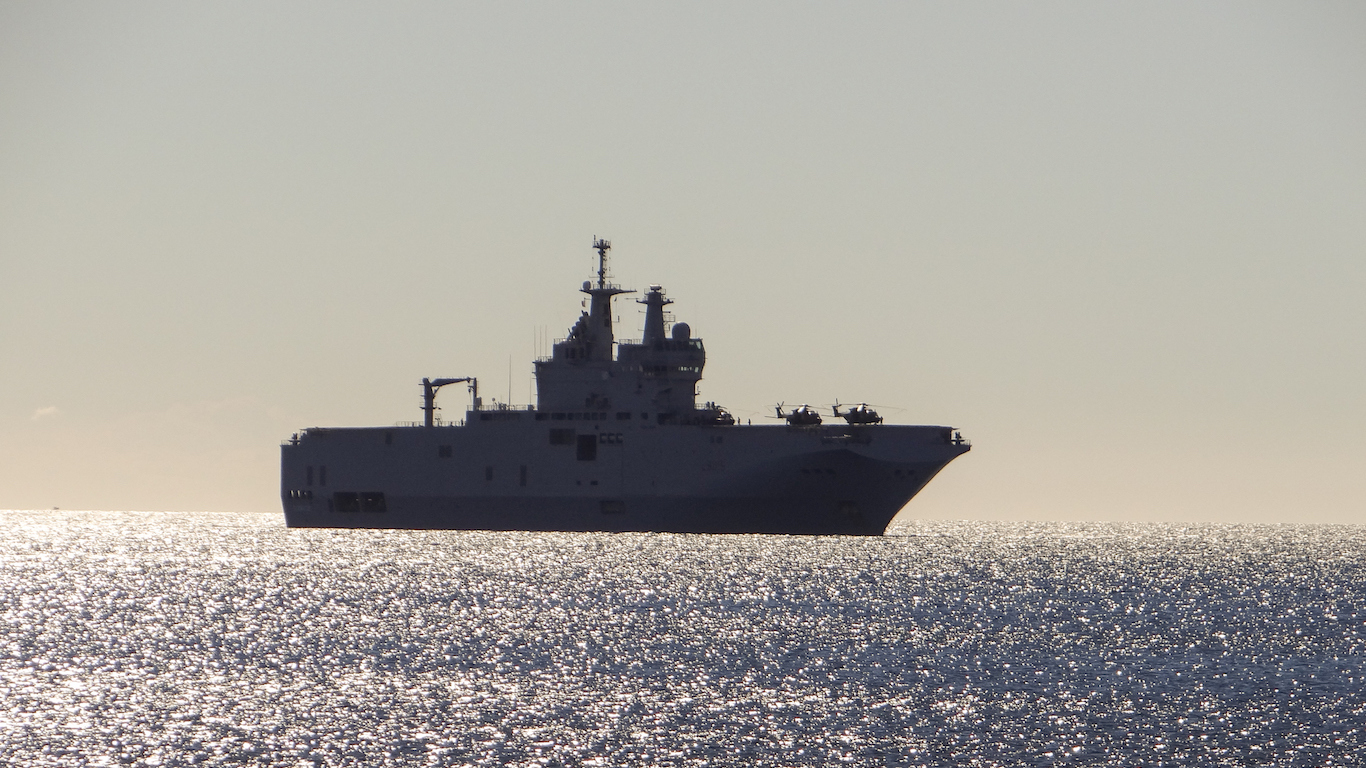
6. France
strong>> Military expenditure: $55.7 billion
> Pct. change military expenditure, 2007-2016: 2.8%
> Expenditure as pct. of GDP: 2.3%
> Per capita military expenditure: $862
France spent $55.7 billion on defense in 2016. Since the United Kingdom voted to leave the European Union in June 2016, France has effectively inherited the mantel as EU’s largest military power. The French military has approximately 10,300 personnel deployed overseas, with nearly 6,000 in Africa, about 3,200 in Iraq, and 900 in Lebanon. Since the November 2015 terrorist attacks in Paris, the French Armed Forces also increased its domestic presence significantly throughout 2016. The effort, called Operation Sentinelle, placed 10,000 combat troops on French streets, roughly 6,500 of which stationed in Paris. The operation represents the largest French domestic military presence since the Algerian war in the 1960s.
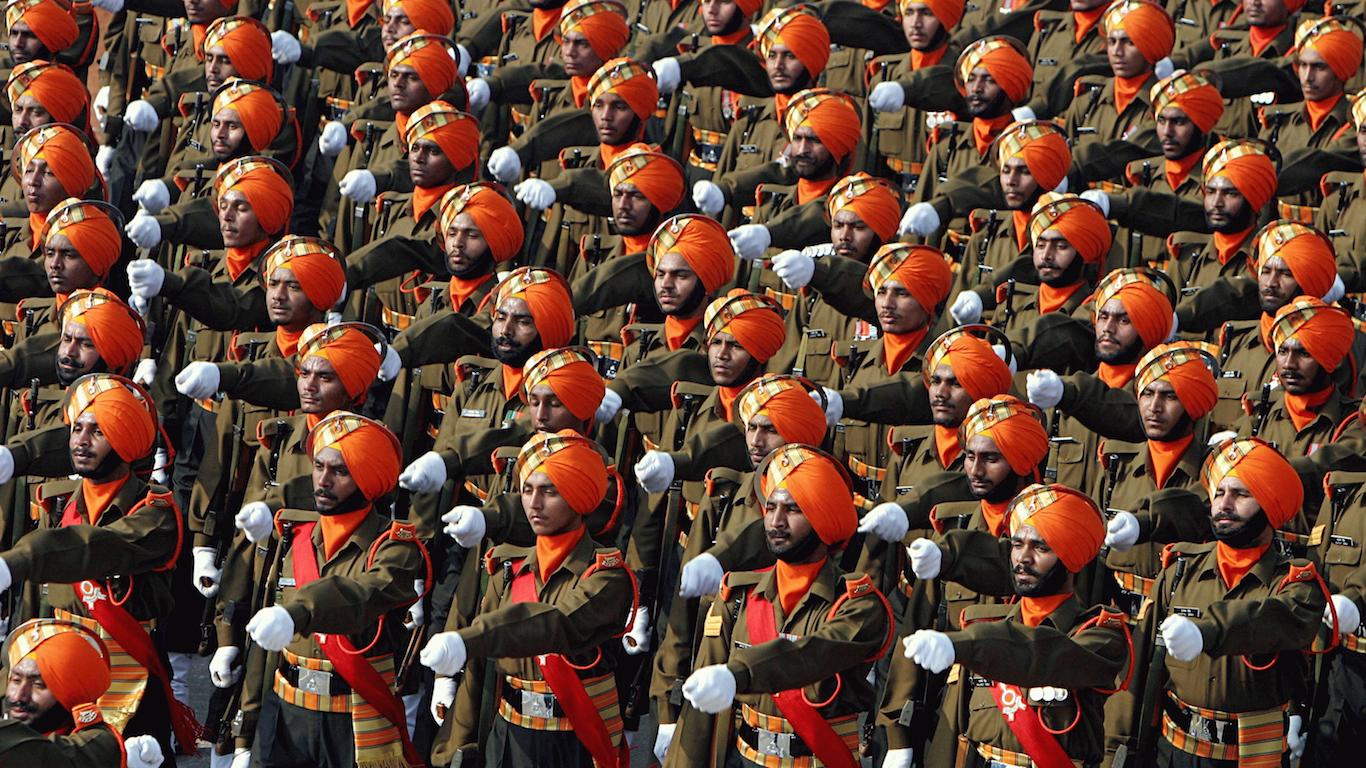
5. India
> Military expenditure: $55.9 billion
> Pct. change military expenditure, 2007-2016: 54.0%
> Expenditure as pct. of GDP: 2.5%
> Per capita military expenditure: $42
India’s $55.9 billion military budget is in large part the result of tensions with its neighbor, Pakistan. India’s 2,000 mile border with Pakistan is one of the most dangerous and volatile in the world. Today, the potential for conflict between the two nuclear powers looms incessantly. Tensions between India and Pakistan escalated throughout 2016, culminating in both countries expelling diplomats from their respective nation over suspicions of espionage and an uptick in cross-border shootings.
Not only does India’s military budget eclipses that of all but four other countries, but also the 2.5% share of the country’s GDP allocated to the military is higher than most.
[in-text-ad]
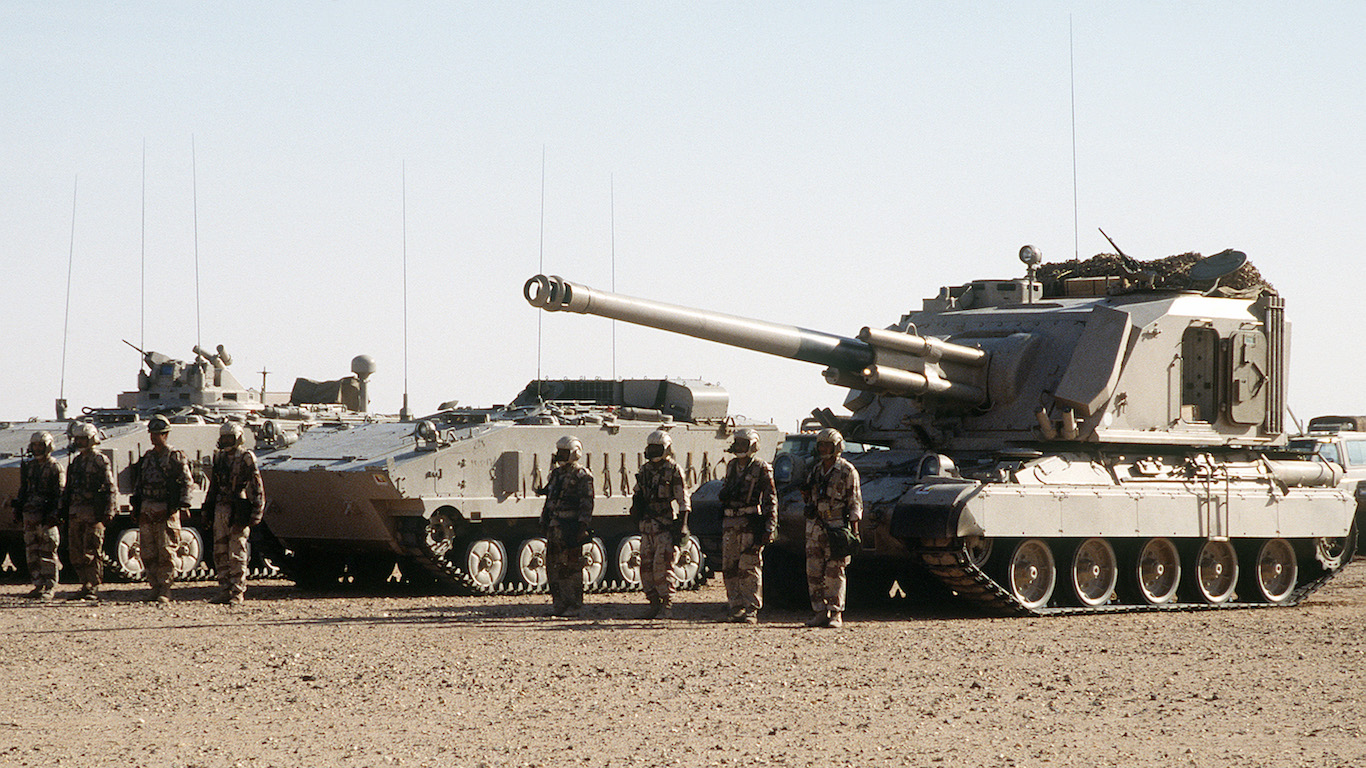
4. Saudi Arabia
> Military expenditure: $63.7 billion
> Pct. change military expenditure, 2007-2016: 20.0%
> Expenditure as pct. of GDP: 10.0%
> Per capita military expenditure: $1,978
Saudi Arabia spent $63.7 billion on its military in 2016, well above major military powers such as France and Germany, despite having less than half the population of either country. Saudi Arabia is one of the wealthiest nations in one of the least stable regions in the world. Given the number of violent conflicts that have taken place recently — wars in Iraq, Syria, and Yemen, uprisings in Turkey and Egypt, and the emergence of ISIS — the nation has plenty of reasons to beef up military spending. The nation’s total arms expenditure increased by 20% over the past decade.
In 2016, the country’s defense budget accounted for 10% of its GDP, by far the greatest relative expenditure of any countries on this list. The next largest spender relative to economic size on this list is another country in the region Israel, which spends 5.8% of its GDP on defense.
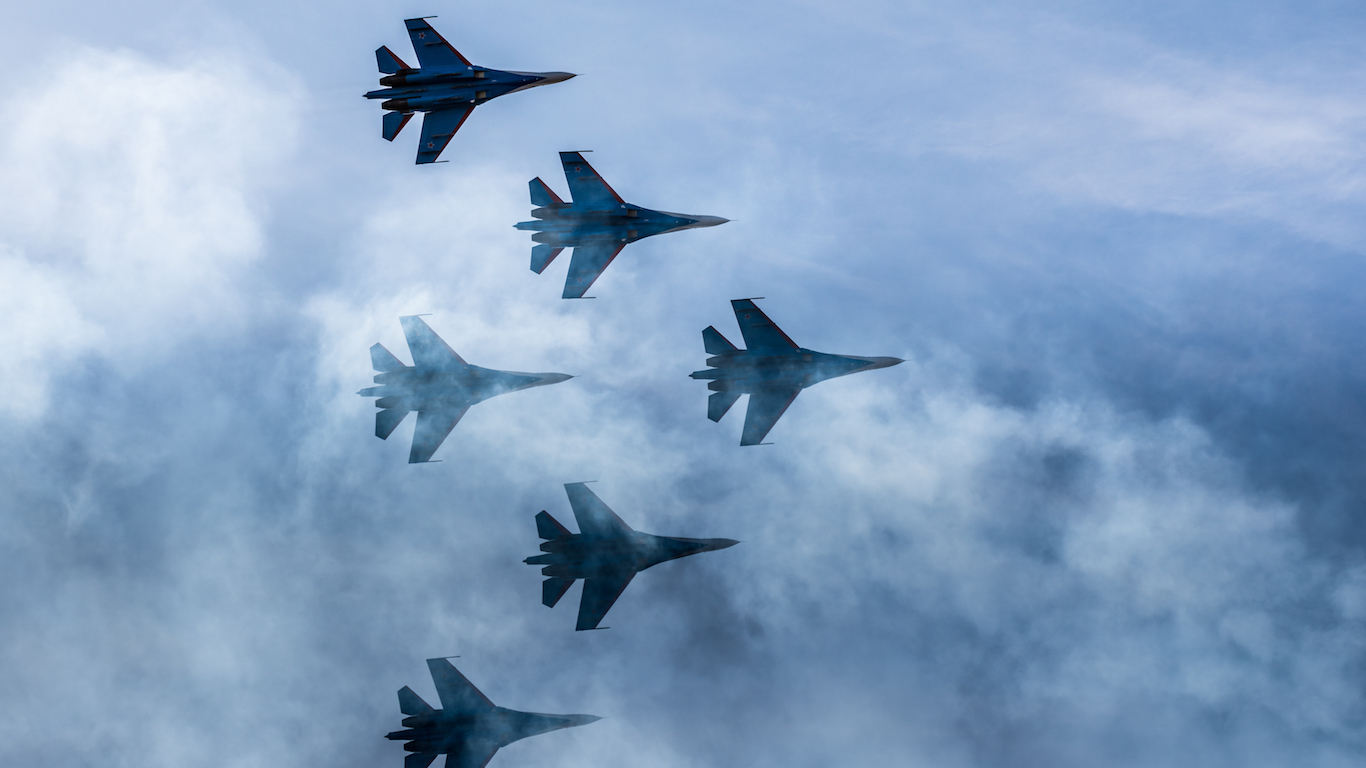
3. Russia
> Military expenditure: $69.2 billion
> Pct. change military expenditure, 2007-2016: 87.0%
> Expenditure as pct. of GDP: 5.3%
> Per capita military expenditure: $483
Russia’s $69.2 billion military budget accounts for 5.3% of the its GDP, a larger share than all but six other countries reviewed by SIPRI and well above the 3.3% share the U.S. spends. Russia’s 2016 military budget is part of a $360 billion long-term plan, announced by Russian President Vladimir Putin in 2011, to modernize Russia’s military. A historic adversary of the United States, Russia is currently providing military support to Bashar Al-Assad’s regime in Syria.
Russia is also home to some of the largest defense contractors in the world — including United Shipbuilding Corporation and United Aircraft Corporation — which serve Russia and other nations abroad.

2. China
> Military expenditure: $215.0 billion
> Pct. change military expenditure, 2007-2016: 118.0%
> Expenditure as pct. of GDP: 1.9%
> Per capita military expenditure: $156
The Chinese military has exploded in size. The nation’s annual armed forces budget has more than doubled in the last 10 years. The Asian powerhouse spent $215 billion on its military last year, more than the expenditures of India, Saudi Arabia, and Russia combined. The most populous nation in the world, China’s armed forces expenditure is just $156 per capita, which falls below that of nearly every nation on this list. The United States, in contrast, has a budget that is well more than double that of China, but spends roughly 12 times as much per capita. While it is well outspent by the United States, China’s military personnel of more than 2.8 million as of 2015 dwarfs that of the U.S.’s 1.3 million as well as of every other nation. In April, China launched its second aircraft carrier, although the ship will not be fully operational until 2020.
[in-text-ad-2]

1. United States
> Military expenditure: $611.0 billion
> Pct. change military expenditure, 2007-2016: -4.8%
> Expenditure as pct. of GDP: 3.3%
> Per capita military expenditure: $1,886
The United States spent a total of $611 billion on defense in 2016, or 36% of total world defense expenditure. Supporting the largest and most powerful military on the planet, the U.S. defense budget is well more than double China’s $215 billion military expenditure and more than nine times Russia’s $69 billion defense spending.
The United States has 10 operational aircraft carriers, more than any other country by far. According to the Arms Control Association, the U.S. arsenal includes 6,800 nuclear warheads compared to Russia’s inventory of 7,000, and the combined 1,115 warheads of the other seven nuclear-capable countries believed to have stockpiles. U.S. military spending amounts to 3.3% of the national GDP, the lowest level since 2002.
Finding a qualified financial advisor doesn’t have to be hard. SmartAsset’s free tool matches you with up to 3 fiduciary financial advisors in your area in 5 minutes. Each advisor has been vetted by SmartAsset and is held to a fiduciary standard to act in your best interests. If you’re ready to be matched with local advisors that can help you achieve your financial goals, get started now.
Thank you for reading! Have some feedback for us?
Contact the 24/7 Wall St. editorial team.